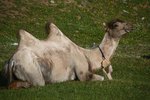
The African wild ass is the granddaddy of the domesticated donkeys of today. It is a desert animal, living primarily in three countries of Africa. It looks like a regular donkey except for its legs, which appear to be wearing black and white striped knee-high socks.
About the African Wild Ass
The African wild ass also is called the Abyssinian wild ass, Somali wild ass, Somali wild donkey and African wild donkey. It is the smallest member of the Equidae family, the same family to which the rhino, horse and tapir belong. They always have had to fight for survival due to the fact that, as desert animals, they live in a hostile environment with an annual rainfall of less than 8 inches, making food and water very scarce. It was listed on the U.S. Fish and Wildlife Service's Endangered Species List in June 1970, and listed as critically endangered in 2004. A hardy animal, biblical references place this animal as far back as 6,000 years ago. It once roamed all over the Moroccan Atlas Mountains and Somalia as well as the Arabian Peninsular. However, now only a small population of them can be found in parts of just three countries: Ethiopia, Eritrea and Somalia.
Habitat Loss
As with so many other animals on the endangered species list, one of the biggest reasons the African wild ass is critically endangered is habitat loss. As cattle ranchers and dairy farmers began claiming grasslands for domestic cattle, the African wild ass was pushed out of areas where it had lived for thousands of years. Farmers, upon seeing them, would shoot on sight or otherwise force them out of the places they would go for food and water until, eventually, very little land was left on which they could survive. Although this animal can go up to three days without water, it does need continuous access to water. As farmers claimed water sources for their own agricultural use, the African wild ass was left to find other places to drink in a place where water already was scarce.
Hunting
The wild African ass has been hunted almost to extinction for its meat. Parts of the animal's body also are used in traditional African and Chinese medicine to cure a plethora of ills, including tuberculosis, rheumatism, back and bone pain, and even constipation. The body parts are made into a soup that is believed to have curative qualities for these maladies. The wild ass reproduces relatively slowly. Females don't reach sexual maturity until they are about 3 to 4 years of age, the gestation period is an entire year, and they only bear young every other year. Therefore, the animals taken during the hunt are not replaced quickly, causing their numbers to decline. Artillery used during the war between Ethiopia and Eritrea was left in and around areas where the African wild ass lives when the war ended. These guns were found by people who began using them to hunt, making them more proficient at slaughter.
Interbreeding
With donkeys so prevalent in the world today it's hard to believe that any donkey could be endangered. Interbreeding has created a hybrid of the African wild ass and there are less than 570 true African wild asses -- feral donkeys with the genetic makeup of a particular taxonomy -- left in the wild. They number less than 100 in captivity in zoos around the world. To differentiate among the types of wild asses and their status, the Convention on International Trade in Endangered Species (CITES) labeled the African wild ass Equus africanus and the domestic ass asinus. The Equus africanus is critically endangered as it interbreeds with the Equus asinus, obliterating the genetic markers that makes it the unique animal it once was.
Conservation
Conservation efforts currently are not underway aggressively to save this species. It's not for lack of interest; civil unrest in the area as well as lack of funds and manpower to catch poachers are the biggest reasons these animals are not protected diligently. There are a few protected areas, but they are not policed because they are so remote and arid. This species truly is on the threshold of complete extinction.
References
- Edge of Existence: African Wild Ass (Equus asinus)
- Konica Minolta: Our Endangered Animals
- International Union for Conservation of Nature Red List -- Equus africanus
- Earth's Endangered Creatures: African Wild Ass
- US Fish and Wildlife Service: African Wild Ass (Equus africanus)
- The Mayway Mailer: Equus Asinus and the Endangered Species Act
- Encyclopedia of Life: Equus Africanus
- Global Issues: Conflict between Ethiopia and Eritrea
Photo Credits
-
Thinkstock Images/Comstock/Getty Images
Writer Bio
Michelle A. Rivera is the author of many books and articles. She attended the University of Missouri Animal Cruelty School and is certified with the Florida Animal Control Association. She is the executive director of her own nonprofit, Animals 101, Inc. Rivera is an animal-assisted therapist, humane educator, former shelter manager, rescue volunteer coordinator, dog trainer and veterinary technician.




